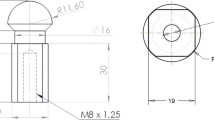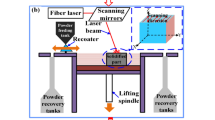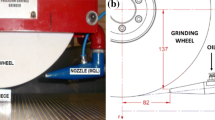Abstract
Surface texture of stamping tools affects the performance of the tool, tool life, and surface quality of the stamped product. In this work, punch samples were machined after heat treatment by milling and turning strategies in super finish processes and part of the punches were submitted either to plasma nitriding or nitrocarburizing treatment before the experiments using hot stamping of washers, which were made in two stages. Based on roughness results, for non-treated punches, most of the milled punches presented more intense surface damage than turned punches after hot stamping process, possibly due to the marks left by machining processes, affecting mechanical obstacles to wear evolution and lubricant retention on punch surface. For nitrided punches, surface damage was less intense than it was on non-treated punches. Parallel contours strategy and turning upward strategy presented less intense surface damage after the hot stamping process. For nitrocarburized punches, surface damage was less intense than it was to non-treated punches, mainly for milling strategies. SEM images of nitrided and nitrocarburized punches suggested alveolar corrosion occurrence during hot stamping process for circular upward strategy.










Similar content being viewed by others
References
Castanhera IC, Diniz AE (2020) Effects of tool path strategies and thermochemical treatments on the surface roughness of hardened punches for hot stamping. J Braz Soc Mech Sci Eng 42:214. https://doi.org/10.1007/s40430-020-02306-5
Arnone M (1998) High performance machining, 1st edn. Hanser Gardner Publication, Cincinnati
Castanhera IC, Diniz AE (2016) High speed milling of hardened steel convex surface. Proc Manuf 5:220–231. https://doi.org/10.1016/j.promfg.2016.08.02
Castanhera IC, Diniz AE (2017) Cutting forces, surface roughness and tool life in high-speed milling of hardened steel convex surface. J Braz Soc Mech Sci Eng 39:3555–3570. https://doi.org/10.1007/s40430-017-0775-z
Kull Neto H, Diniz AE, Pederiva R (2015) Influence of tooth passing frequency, feed direction, and tool overhang on the surface roughness of curved surfaces of hardened steel. Int J Adv Manuf Technol 82:753–764. https://doi.org/10.1007/s00170-015-7419-1
Kull Neto H, Diniz AE, Pederiva R (2016) The influence of cutting forces on surface roughness in the milling of curved hardened steel surfaces. Int J Adv Manuf Technol. https://doi.org/10.1007/s00170-015-7811-x
SANDVIK COROMANT, 2017, Tool catalog D 2017
Souza AF, Machado A, Beckert SF, Diniz AE (2014) Evaluating the roughness according to the tool path strategy when milling free form surfaces for mold application. 6th CIRP international conference on high performance cutting, HPC2014, Berkeley
Sandvik Coromant, 2000. Fabricación de Moldes y Matrices – guia de aplicación, C-1120.2 SPA, in spanish
Scandiffio I, Diniz AE, Souza AF (2016) Evaluating surface roughness, tool life, and machining force when milling free-form shapes on hardened AISI D6 steel. Int J Adv Manuf Technol 82:2075–2086. https://doi.org/10.1007/s00170-015-7525-0
Hioki D, Diniz AE, Sinatora A (2013) Influence of HSM cutting parameters on the surface integrity characteristics of hardened AISI H13 steel. J Braz Soc Mech Sci Eng 35:537–553. https://doi.org/10.1007/s40430-013-0050-x
Magri M, Diniz AE, Button ST (2013) Influence of surface topography on the wear of hot forging dies. Int J Adv Manuf Technol 65:459–471. https://doi.org/10.1007/s00170-012-4185-1
ASM, American Society for Metals (1995), Metals handbook, 9th edition, v14
ASM, American Society for Metals (1995), Metals handbook, 9th edition, v16
Fernandes L, Silva FJG, Andrade MF, Alexandre R, Baptista APM, Rodrigues C (2017) Improving the punch and die wear behavior in tin coated steel stamping process. Surf Coat Technol. https://doi.org/10.1016/j.surfcoat.2017.06.086
Kim DH, Lee HC, Kim BM, Kim KH (2005) Estimation of die service life against plastic deformation and wear during hot forging processes. J Mater Process Technol 166:372–380. https://doi.org/10.1016/j.jmatprotec.2004.07.103
Li S, Wu X, Chen S, Li J (2016) Wear resistance of H13 and a new hot-work die steel at high temperature. JMEPEG 25:2993–3006. https://doi.org/10.1007/s11665-016-2124-2
Straffelini G, Verma PC, Metinoz I, Ciudin R, Perricone G, Gialanella S (2016) Wear behavior of a low metallic friction material dry sliding against a cast iron disc: Role of the heat-treatment of the disc. Wear. https://doi.org/10.1016/j.wear.2015.11.020
Venema J, Hazrati J, Matthews DTA, Stegeman RA, van den Boogaard HA (2018) The effects of temperature on friction and wear mechanisms during direct press hardening of Al-Si coated ultra-high strength steel. Wear 406-407:149–155. https://doi.org/10.1016/j.wear.2018.04.006
WHITEHOUSE D (2003) Handbook of surface and nanometrology, digital edn. IOP Publishing Ltd., London
Jhavar S et al (2013) Causes of failure and repairing options for dies and molds: a review. Eng Fail Anal 34:519–535
Ebara R (2009) Microfractography in failure analysis of cold forging dies. Eng Fail Anal 16:1968–1976
ASM, American Society for Metals (1995), Metals handbook, 9th edition, v3
ASM, American Society for Metals (1995), Metals handbook, 9th edition, v4
ASM, American Society for Metals (1995), Metals handbook, 9th edition, v9
Callister WD Jr, Rethwisch DG (2018) Materials science and engineering: an introduction, 10th edn. Wiley, New York
Unal O, Maleki E, Varol R (2018) Effect of severe shot peening and ultra-low temperature plasma nitriding on Ti-6Al-4V alloy. Vacuum 150:69–78. https://doi.org/10.1016/j.vacuum.2018.01.027
Unal O, Maleki E, Varol R (2019) Plasma nitriding of gradient structured AISI 304 at low temperature: shot peening as a catalyst treatment. Vacuum 164:194–197. https://doi.org/10.1016/j.vacuum.2019.03.027
Marušić K, Otmačić H, Landek D, Cajner F, Stupnišek-Lisac E (2006) Modification of carbon steel surface by the Tenifer® process of nitrocarburizing and post-oxidation. Surf Coat Technol 201:3415–3421. https://doi.org/10.1016/j.surfcoat.2006.07.231
Laitinen, T., (1999). Thiosulfate pitting corrosion of stainless steel in paper machine environment, doctoral thesis, Technical Research Centre of Finland, Espoo: VTT Publications
Perez M, Belzunce FJ (2016) A comparative study of salt-bath nitrocarburizing and gas nitriding followed by post-oxidation used as surface treatments of H13 hot forging dies. Surf Coat Technol 305:146–157. https://doi.org/10.1016/j.surfcoat.2016.08.003
Widomski P, Gronostajski Z (2020) Comprehensive review of methods for increasing the durability of hot forging tools. Proc Manuf 47:349–355
Behrens BA (2008) Finite element analysis of die wear in hot forging processes. CIRP Ann Manuf Technol 57:305–308. https://doi.org/10.1016/j.cirp.2008.03.087
Cao T, Lu B, Ou H, Long H, Chen J (2016) Investigation on a new hole-flanging approach by incremental sheet forming through a featured tool. Int J Mach Tool Manu 110:1–17. https://doi.org/10.1016/j.ijmachtools.2016.08.003
Cristino VA, Montanari L, Silva MB, Atkins AG, Martins PAF (2014) Fracture in hole-flanging produced by single point incremental forming. Int J Mech Sci 83:146–154. https://doi.org/10.1016/j.ijmecsci.2014.04.001
Dewang Y, Purohit R, Tenguria N (2017) A study on sheet metal hole-flanging process. Mater Today: Proceedings 4:5421–5428
Cui Z, Gao L (2010) Studies on hole-flanging process using multistage incremental forming. CIRP J Manuf Sci Technol 2:124–128. https://doi.org/10.1016/j.cirpj.2010.02.001
NANOVEA, (2012). Surface roughness statistical analysis using 3D Profilometry, http://nanovea.com/App-Notes/roughness-statistical-analysis.pdf, accessed in October 7th 2019
Toboła D, Brostow W, Czechowski K, Rusek P (2017) Improvement of wear resistance of some cold working tool steels. Wear 382-383:29–39. https://doi.org/10.1016/j.wear.2017.03.023
Acknowledgments
The authors acknowledge “Fundação de Apoio à Pesquisa do Estado de São Paulo (FAPESP)” (process number 2013/00551-7), DEMM-FEM/UNICAMP, and Ace Supertrat LTDA, which cooperated with heat treatment and nitrocarburizing processes, for making this paper possible.
Availability of data and materials
All the data and materials of this work are available to the readers, according to the magazine policies.
Funding
This work was funded by Fundação de Amparo à Pesquisa do Estado de São Paulo (grant number 2013/00551–7) and University of Campinas (Brazil), university where two authors work (Diniz and Button) and where one author (Castanhera) used to be a doctorate student during the work execution.
Author information
Authors and Affiliations
Contributions
All authors whose names appear on the submission:
1) Made substantial contributions to the conception or design of the work, or the acquisition, analysis, or interpretation of data
2) Drafted the work or revised it critically for important intellectual content
3) Approved the version to be published
4) Agree to be accountable for all aspects of the work in ensuring that questions related to the accuracy or integrity of any part of the work are appropriately investigated and resolved.
In other words, the three authors had important participation in all phases of the work.
Corresponding author
Ethics declarations
Ethical approval
The authors declare that they agree with the “Ethical Responsibilities of Authors” section of the document which is in https://www.springer.com/journal/10096/submission-guidelines?IFA.
Consent to participate
All the authors consent to participate in this publication.
Consent to publish
All the authors consent with the publication of this work in the International Journal of Advanced Manufacturing Technology. Moreover, the university the authors are engaged to also consents with this publication.
Competing interests
The authors declare that they do not have any competing interests/conflict of interest.
Additional information
Publisher’s note
Springer Nature remains neutral with regard to jurisdictional claims in published maps and institutional affiliations.
Rights and permissions
About this article
Cite this article
da Costa Castanhera, I., Diniz, A.E. & Button, S.T. Effects of plasma nitriding and nitrocarburizing thermochemical treatments and surface texture on surface damage evolution of hot stamping punches. Int J Adv Manuf Technol 112, 2341–2358 (2021). https://doi.org/10.1007/s00170-020-06424-1
Received:
Accepted:
Published:
Issue Date:
DOI: https://doi.org/10.1007/s00170-020-06424-1




